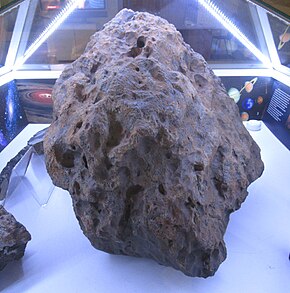
Back نيزك تشيليابينسك ARZ Tsjeljabínsk-steinninn Icelandic チェリャビンスク隕石 Japanese Czelabińsk (meteoryt) Polish Челябинск (метеорит) Russian Chelyabinsk meteorite Singhalese Чељабински метеорит Serbian Челябінськ (метеорит) Ukrainian 車里雅賓斯克隕石 Chinese
| Chelyabinsk | |
|---|---|
 Largest fragment of the meteorite at the exhibition of The State Museum of the South Ural History. | |
| Type | Ordinary chondrite LL5[1] |
| Shock stage | S4[2] |
| Weathering grade | W0 (pristine) |
| Country | Russia |
| Region | Chelyabinsk Oblast |
| Coordinates | 54°57′18″N 60°19′30″E / 54.95500°N 60.32500°E |
| Observed fall | Yes |
| Fall date | 15 February 2013, 09:20 YEKT (UTC+06:00) |
| Found date | 27 February 2013 |
| TKW | approximately 1,000 kg (2,200 lb)[3] |
| Strewn field | Yes |
The Chelyabinsk meteorite (Russian: Челябинский метеорит, Chelyabinskii meteorit) is the fragmented remains of the large Chelyabinsk meteor of 15 February 2013 which reached the ground after the meteor's passage through the atmosphere. The descent of the meteor, visible as a brilliant superbolide in the morning sky, caused a series of shock waves that shattered windows, damaged approximately 7,200 buildings and left 1,491 people injured.[4][5][6] The resulting fragments were scattered over a wide area.
The largest fragment raised from the bottom of Lake Chebarkul on 16 October 2013 had a mass of 540 kg (1,190 lb)[7] and the total mass of other 7 meteorite fragments found nearby was 84.4 kg (186 lb).[7]
- ^ "Chelyabinsk". Meteoritical Bulletin Database. The Meteoritical Society. Archived from the original on 2013-06-03.
- ^ "Google Translate" Тип челябинского метеорита оказался уникальным для России - ученые [Chelyabinsk meteorite type was unique for Russia - Scientists] (in Russian). ria.ru. 28 February 2013. Archived from the original on 2013-06-26.
- ^ Kocherov, A.V.; Ivanova, M.A. "Chelyabinsk, recovery of additional masses". Meteoritical Bulletin Database. The Meteoritical Society. Archived from the original on 23 December 2015. Retrieved 23 December 2015.
- ^ Число пострадавших при падении метеорита приблизилось к 1500 [The number of victims of the meteorite approached 1500] (in Russian). РосБизнесКонсалтинг [RBC]. 18 February 2013. Archived from the original on 2 May 2013. Retrieved 18 February 2013.
- ^ "Russische Wissenschaftler finden Teile des Meteoriten" [Russian scientists find parts of the meteorite]. Zeit (in German). 18 February 2013. Archived from the original on 2013-04-20.
- ^ "Meteorite-caused emergency situation regime over in Chelyabinsk region". Russia Beyond The Headlines. Rossiyskaya Gazeta. Interfax. 5 March 2013. Archived from the original on 23 June 2013. Retrieved 17 April 2013.
- ^ a b "45th Lunar and Planetary Science Conference (2014) - Recovery, Laboratory Preparation and Current State of the Main Mass of the Chelyabinsk Meteorite" (PDF). 21 March 2014. Archived (PDF) from the original on 4 May 2020. Retrieved 22 July 2020.